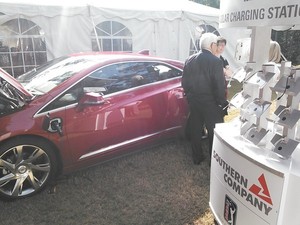An additional 90 megawatts of solar power by Georgia Power,
beyond what the GA PSC required last summer?
With whose Army?
Kristi E. Swartz wrote for EnergyWire 16 May 2014,
Georgia Power plan would install solar arrays on 3 Army bases,
 Georgia Power and the
Army jointly released plans to install large
solar arrays at three military bases yesterday in what officials say
could be a model for other states.
Georgia Power and the
Army jointly released plans to install large
solar arrays at three military bases yesterday in what officials say
could be a model for other states.
The three solar arrays are scheduled to start producing power in
2015 and will lead to the Army getting 18 percent of its electricity
in Georgia from renewable fuels that are on-site.
The 90 total megawatts of solar electricity also will move the Army
9 percent closer to meeting federal goals for renewable energy.
Adding three 30 MW arrays would continue to boost Georgia’s rapidly
growing solar output and would help the military meet its renewable
energy goals to become sustainable and more secure.
The move also alleviates mounting political and public pressure on
Georgia Power to remove roadblocks that some say have made it
difficult for the military to meet its federal renewable energy
goals.
OK, that’s all good stuff.
However, I’m missing the part about SO is going beyond what GA PSC
required Georgia Power to do:
“From the commission standpoint, it’s a joint venture between the
Georgia Public Service Commission and the Georgia Power Co. It is a
partnership,” PSC member Lauren “Bubba” McDonald said in an
interview with EnergyWire. “Georgia will be the model state.”
At least a couple of state utility regulators have been working with
Georgia Power for months on a program specifically to install solar
at military bases. The utility will use a 90 MW self-build project
that the Georgia Public Service Commission approved in 2007 to
implement its plans.
 So if that 90 MW was approved by GA PSC in 2007, how is it
beyond
the 525 MW GA PSC required of Georgia Power last summer?
Maybe Georgia Power and GA PSC won’t count that 90MW within the 525 MW.
This could confirm that interpretation:
So if that 90 MW was approved by GA PSC in 2007, how is it
beyond
the 525 MW GA PSC required of Georgia Power last summer?
Maybe Georgia Power and GA PSC won’t count that 90MW within the 525 MW.
This could confirm that interpretation:
McDonald said this program is an extension of his efforts last
summer when he shepherded a proposal to have Georgia Power add 525
MW of solar to the grid as part of the utility’s long-term energy
plan.
OK, that’s good.
It’s still not enough: Georgia Power should be doubling its solar
generation every year, not just adding 17% above what it’s required.
But it’s some sort of acknowledgement that something needs to be done,
and it is something Georgia Power is actually doing.
-jsq
 According to Sabal Trail’s own numbers, twice as much land for
the entire three-pipeline Spectra -> Sabal -> FSC proposed gouge
through three states
as would be required to produce as much solar power.
According to Sabal Trail’s own numbers, twice as much land for
the entire three-pipeline Spectra -> Sabal -> FSC proposed gouge
through three states
as would be required to produce as much solar power.









